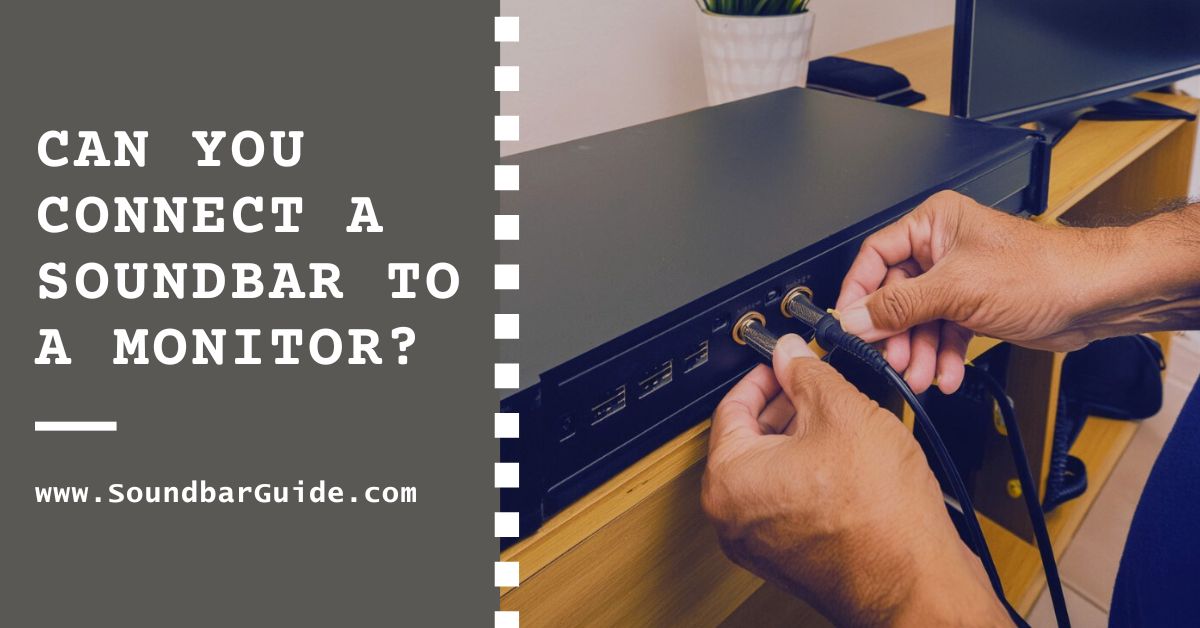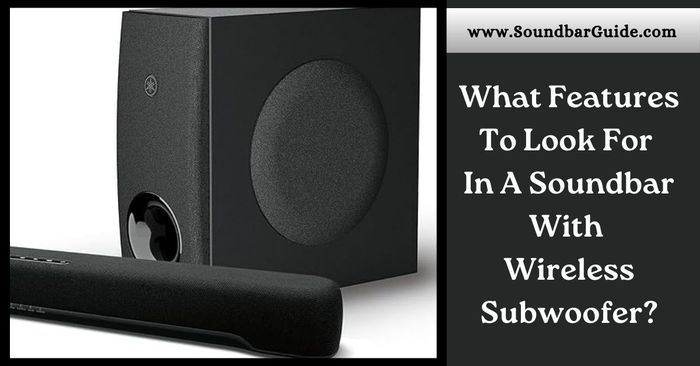Connecting a soundbar to a monitor enhances your audio experience, especially if your monitor doesn’t have built-in speakers or they’re of low quality.
This simple addition can significantly improve the sound for gaming, watching videos, or casual listening while you work.
But, can you connect a soundbar to a monitor?
Well, yes, you can connect a soundbar to a monitor. This setup requires a monitor with audio output and a compatible soundbar input.
Keep in mind that soundbars offer a compact, stylish solution for better audio without the complexity or space requirements of a full surround sound system.
They typically connect through standard audio outputs like HDMI, optical, or headphone jacks found on many modern monitors.
Always make sure to check the compatibility of connections on both devices to ensure a smooth setup.
Remember that a quality soundbar can transform your auditory experience, making it a popular choice for users seeking simplicity and improved sound.
In this post, I am going to share a detailed discussion on whether you can connect a soundbar to a monitor.
So, without making any delay, let’s jump in…
Table of Contents
Soundbar & Monitor Connection
Many users seek to enhance their audio experience when engaging with their monitors. A soundbar offers a sleek, space-saving audio solution compared to traditional speakers.
Understanding how to connect a soundbar to a monitor could transform the audio dimension of gameplay, movie watching, or any multimedia experience.
Why Connect A Soundbar To A Monitor?
Here are simple reasons for making the connection:
- Better Sound Quality: Soundbars provide superior audio over built-in monitor speakers.
- Space Efficiency: They require less space than typical speakers, ideal for minimal setups.
- Easy Setup: Modern soundbars offer simple plug-and-play connectivity.
- Esthetic Appeal: Their sleek design complements modern monitor aesthetics.
Potential Benefits
Considering adding a soundbar to your monitor setup? Reflect on these advantages:
- Immersive Sound: Experience richer, more layered audio during media consumption.
- Clutter-Free: Dodge the mess of multiple wires and bulky speakers.
- Enhanced Productivity: Clear sound can increase focus and reduce distractions.
- Versatility: Some soundbars also support Bluetooth, doubling as standalone music players.
Read More: Connecting Soundbar To Vizio TV.
Compatibility Check
Compatibility Check is crucial before pairing a soundbar with a monitor. Ensuring your devices can communicate is key for a seamless audio experience. With various types and models, a systematic check is a must.
Let’s explore what you need to know to connect your soundbar to your monitor effectively…
Types Of Monitors And Soundbars
Selecting the right monitor and soundbar starts with understanding the types available. Monitors range from standard, without built-in speakers, to advanced models featuring HDMI ARC support.
Soundbars offer diverse shapes and sizes, equipped for basic to high-fidelity audio. Some even support Bluetooth connectivity. Match both for compatibility before proceeding.
Identifying Connection Options
Pinpointing available connection ports on your devices is essential. Common links include HDMI, Optical, Aux, or USB ports. Some modern soundbars and monitors allow wireless pairing through Bluetooth. Matching the connection types ensures the devices will work together properly.
You can use the table below to guide you in selecting compatible ports between your monitor and soundbar.
| Monitor Type | Available Ports | Soundbar Type | Compatible Ports |
|---|---|---|---|
| Standard Monitor | Aux, HDMI | Basic Soundbar | Aux, HDMI |
| Advanced Monitor | HDMI ARC, Optical | High-End Soundbar | HDMI ARC, Optical |
| Monitor with Bluetooth | Bluetooth | Wireless Soundbar | Bluetooth |
Read More: Connecting Bluetooth Soundbar To Xbox One.
Connection Types Explained
Soundbars amplify sound making movies and games more immersive. Different cables connect soundbars and monitors.
Let’s explore these cables…
HDMI: Audio And Video Together
HDMI stands for High Definition Multimedia Interface. It’s common and easy to use. HDMI carries both audio and video signals. This means you can have a single cable for sound and picture.
Here’s why HDMI rocks:
- Simple setup with one cable
- Support high-quality audio formats
- No separate audio cable needed
Most modern soundbars and monitors have HDMI ports. Look for a port labelled ‘HDMI ARC’ on your soundbar. ARC means Audio Return Channel. It sends sound from your monitor to your soundbar.
Optical And AUX Connections
Optical and aux cords are audio-specific. They work when HDMI is not an option. Optical cables use light to transmit sound. They offer high-quality audio. Aux cables, also known as 3.5 mm cables, are simple but effective.
Here’s a breakdown:
| Connection Type | Quality | Use Case |
|---|---|---|
| Optical | Very Good | TVs without HDMI ARC |
| Aux (3.5mm) | Good | PC monitors and laptops |
If your monitor lacks HDMI, go optical for TVs or aux for computers. Ensure your soundbar has matching inputs.
Can You Connect A Soundbar To A Monitor – The Process
Sound bars elevate your audio experience. Connecting one to a monitor might seem daunting.
But, worry not!
This Step-by-Step Connection Guide ensures a seamless setup…
Preparing Your Devices
Start with preparation for hassle-free connection:
- Check compatibility – Your monitor should have audio outputs.
- Gather cables – HDMI, optical, or AUX, depending on your connections.
- Update firmware – Ensure both devices have the latest software.
- Clear space – Position your soundbar close to the monitor for easy access.
Establishing The Connection
Follow these simple steps to connect:
- Turn off devices before connecting them.
- Choose the right cable for your output choice.
- Connect one end to the soundbar’s input.
- Attach the other end to the monitor’s audio output.
- Power on both devices.
- Navigate to the monitor’s audio settings.
- Select the soundbar as the default speaker.
- Play a test sound to confirm connection.
Now, enjoy the full spectrum of sound with your monitor and soundbar setup!
Troubleshooting Common Issues
Setting up your soundbar with a monitor should be simple. Sometimes, things don’t go as planned. You may encounter issues like no sound or poor audio quality. This section will guide you through common problems so you can enjoy clear, crisp sound in no time.
No Sound Output
If your soundbar isn’t producing any sound when connected to your monitor, follow these steps:
- Check the connection: Ensure cables are firmly plugged in.
- Examine input settings: Select the correct audio output on both devices.
- Update drivers: For PCs, verify sound card drivers are up to date.
- Restart devices: Turn off both soundbar and monitor, then reboot.
Poor Sound Quality
Poor audio quality can be frustrating. Here’s what to check:
- Review sound settings: Adjust the bass, treble, and balance properly.
- Inspect cable integrity: Replace any damaged or frayed cables.
- Soundbar placement: Position your soundbar where it’s unobstructed.
- Firmware updates: Keep your soundbar’s firmware current.
If these steps don’t resolve the issues, consult the user manual or reach out to technical support.
FAQs On Connecting Soundbar To Monitor
How Do You Connect Soundbar To TV Using Bluetooth?
To connect a soundbar to a TV using Bluetooth, first, ensure both devices have Bluetooth functionality. Then, put the soundbar in pairing mode and search for it on your TV’s Bluetooth settings. Once paired, select the soundbar as the audio output device on your TV settings, and you’re ready to enjoy wireless audio from your TV through the soundbar.
Can I Use A Soundbar As A Center Speaker?
Yes, you can use a soundbar as a center speaker in a home theater setup, but it’s not always the optimal solution. While it can work in some cases, dedicated center speakers are designed specifically for dialogue clarity and may provide better performance and integration with surround sound systems.
How Do You Connect Soundbar To Projector?
To connect a soundbar to a projector, you typically use either an HDMI ARC (Audio Return Channel) connection or an optical audio cable. Simply plug one end of the cable into the soundbar and the other into the projector’s corresponding port, then adjust the audio settings on both devices as needed for optimal sound output.
Can Samsung Soundbar Connect To Any TV?
Yes, Samsung Soundbars can generally connect to any TV that has compatible audio output ports, such as HDMI ARC, optical audio, or Bluetooth. Compatibility may vary based on the specific model and connections available on both the Soundbar and the TV.
What Are The Best Budget 5.1 Soundbars With Wireless Rear Speakers?
The best budget 5.1 soundbars with wireless rear speakers offer a balanced mix of immersive surround sound and affordability. These soundbars typically provide easy wireless connectivity, enhanced audio quality, and a seamless setup, making them ideal for home entertainment without breaking the bank.
Conclusion
Connecting a soundbar to your monitor enhances audio quality for an immersive experience. The process is straightforward, with several methods available.
Try to embrace the power of great sound; it transforms how you enjoy multimedia. Explore your options, ensure compatibility, and elevate your auditory journey today.
Lastly, if you want to get latest tips about soundbars and similar other gadgets, you can visit this blog.
This is what I have planned to share with you this time.
See you soon!


![How To Connect Vizio Soundbar To Vizio TV: [Step By Step Guide]](https://soundbarguide.com/wp-content/uploads/2024/10/how-to-connect-vizio-soundbar-to-vizio-tv.jpg)


Leave a Reply